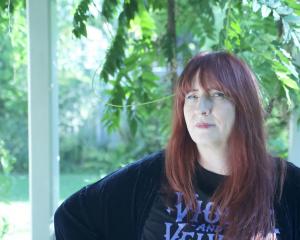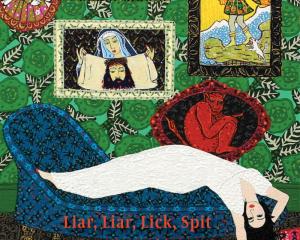The east coast of the South Island is a little bit special, writes Linda Burgess in this extract from her book, Historic Churches: A Guide to Over 60 Early New Zealand Churches.
I love the South Island's east coast: Kaikoura and its seals - watching their antics is a bit like watching Coronation Street, though less murderous - and Moeraki with its incredible boulders.
How could nature have been so meticulous as to shape them so perfectly? For some years another reason to visit Moeraki has been Fleur Sullivan's restaurant, Fleurs Place.
A third very rewarding thing to do is to take a wander round the little blue church, built in 1862 and the oldest surviving Maori mission building in the South Island. Unfortunately, like many little churches these days, its doors tend to be locked.
The church hasn't always sat where it is today - indeed it has been relocated twice. In 1961, acknowledging that most of the Maori population had moved from the Kaik to Moeraki, the church was moved from the Kaawa Cemetery Maori Reserve to a site at the west end of Moeraki's Centenary Park.
It was rededicated on Boxing Day by the Anglican Bishop of Dunedin as part of Moeraki's 125th anniversary celebrations. But within seven years it was discovered that the ground at Centenary Park was too unstable for the building and it was moved again to its present site - a former quarry on Haven St.
Moeraki is one of the oldest continuously occupied settlements in New Zealand. Archaeological excavations show humans occupied the area while moa were still available to eat - so since at least the 13th century.
Europeans arrived in late 1836 when John Hughes and his crew came ashore to set up a whaling station. The ship had come from Banks Peninsula, and the party was made up of six Maori and six Europeans.
These days the coast is known for watching whales rather than killing them, but in that first whaling season the crews from two boats killed 23 whales from the Moeraki base. During that first season a heke (migration party) of Kai Tuahuriri, led by Matiaha Tiramorehu, left Kaiapoi for Moeraki.
There had been half a decade of fighting with Ngati Toa's Te Rauparaha and the feud was unresolved. With permission from Paitu, the rangatira of the Moeraki area, they settled about 3km from what is now Moeraki township at Tawhiroko Point. Subsequently it became known as the Kaik.
Tiramorehu was to become one of the area's most significant inhabitants. He was from a high ranking Ngai Tahu family, and was a highly intelligent, well educated man.
He was educated at the whare wananga (school of higher learning) at Maungamaunu.
The Reverend James Watkin, a Wesleyan missionary, noted that Tiramorehu was ''better acquainted with genealogical antiquities than any other person''. When Paitu died, Tiramorehu became the rangatira of the settlement.
In 1840 the first Christian mission among Ngai Tahu was established by Watkin at Waikouaiti.
The Wesleyans weren't the only Christians keen to move into the district: in December 1840 the Catholic Bishop Pompallier preached at Moeraki, and in 1843 Te Rauparaha's son Tamihana preached there on behalf of the Anglican mission.
That year Tiramorehu had converted to Christianity and had been baptised by Watkin. Given the feuding of the previous decade, it's not hard to understand why he chose not to join Te Rauparaha's son.
He also encouraged his Moeraki community to take up the Wesleyan faith, becoming not only a fervent supporter but also a lay preacher. Nevertheless, the region remained ecumenical and the current little church reflects this, being built with support from the Anglican mission. A plaque in the grounds of the church acknowledges the visit of Bishop Pompallier.
Although he was a convert to European agricultural practices, Tiramorehu did not wish to embrace all things European - his community avoided the dissolute way of life associated with the whalers.
Importantly, Tiramorehu was a signatory to the Canterbury purchase negotiated by Henry Kemp in Akaroa in 1848. But by 1849 he knew that there had been unforgivable breaches of the purchase conditions and he took a leading part in protests against them.
A letter he wrote to Lieutenant Governor Eyre in October 1849 was the first formal statement of Ngai Tahu grievances about South Island land purchases. Tiramorehu wrote that this was just the start of complaints, and ''we shall never cease complaining to the white people who may hereafter come here''.
It wasn't just the land, but also broken promises regarding schools and hospitals for Maori. He himself was very involved in education, running a school at Moeraki where instruction in traditional learning was given to young Maori. At least Tiramorehu's concerns were acknowledged, and in 1860 he became one of two native assessors for Otago.
Throughout his life (he died in 1881) he was steadfast and fair in demanding rights for Ngai Tahu. It is thus most appropriate that Tiramorehu is commemorated in a unique way: on a stained glass window in the little church at Moeraki. The three stained glass windows are known collectively as the ''Sermon on the Mount'' and were made in Birmingham in 1891.
The central window shows Jesus holding a Bible and the left window depicts Matiaha Tiramorehu. Made 10 years after his death, it's based on a photograph. The depiction of a Maori - indeed, of any New Zealand born person - in a 19th century stained glass window is extremely rare.
Equally fittingly, Tiramorehu's tangi, which drew mourners from around the country, was held in this church and received nationwide attention. Kotahitanga Church continues to play an important role in the local community and is still in use today.
Get it
Historic Churches: A Guide to Over 60 Early New Zealand Churches, by Linda Burgess. Published by Penguin Random House NZ. RRP $50. Photography by Rob Burgess. Reproduced with permission.












